camera
Olympus SP-610UZ
 The Olympus SP-610UZ is a digital camera with a 22x zoom, ranging from wide-angle to ultra-tele and HD video. The f/2.8-5.6 lens is the equivalent of a 28-616 mm focal length. That is an incredible range.
The Olympus SP-610UZ is a digital camera with a 22x zoom, ranging from wide-angle to ultra-tele and HD video. The f/2.8-5.6 lens is the equivalent of a 28-616 mm focal length. That is an incredible range.
The camera is equipped with in-camera Magic Filters to enhance and customize images: Pop Art, Pin Hole, Fish-Eye, Soft Focus, Drawing, Watercolour, Sparkle, and Punk.
The SP-610UZ shoots 720p HD video and has a new 3-D Mode. Select the 3D Photo shooting mode, release the shutter for your first shot, slowly pan until the camera automatically takes a second image from a slightly different perspective. The 3D data is processed in-camera resulting in an .mpo file, the universal industry 3D format for easy display on 3D televisions or laptops.
The camera is compatible with an optional Eye-Fi SD card, adding Wi-Fi capability so you can automatically upload images to your computer as you take them.
There’s a 3.0-inch LCD monitor, an upgrade over its predecessor’s 2.7-inch LCD.
Dual Image Stabilization combines two technologies – Mechanical Sensor-Shift Image Stabilization and Digital Image Stabilization. Mechanical Sensor-Shift Image Stabilization keeps images sharp by adjusting the internal image sensor to compensate for camera movement. Digital Image Stabilization freezes the action with high ISO sensitivity and fast shutter speeds.
In-Camera Panorama mode captures three images and stitches them together to create a panoramic picture. Simply press the shutter button and slowly pan across the scene. The second and third images will be captured automatically and stitched together with the first image. Or you can use the Olympus [ib] Software to stitch up to 10 images together.
Face Detection? Of course. The SP-610UZ detects up to 16 faces within the frame and automatically focuses and optimizes exposure. Beauty Mode touches up the appearance of your subject’s skin as the photo is captured.
AF Tracking technology locks focus on fast-moving subjects, continuously adjusts focus and brightness. Two newly designed “Pet Modes” offer the ability to recognize the faces of a variety of breeds of both cats and dogs.
Intelligent Auto Mode automatically identifies what you are shooting (i.e., Portrait, Night + Portrait, Landscape, Macro or Sports) and adjusts the camera’s settings to capture the best quality results.
The SP-610UZ offers a 14-megapixel sensor, and has migrated the technology of the TruePic III+ Image Processor from its DSLRs to this camera. The processor produces crystal clear photos using all the pixel information for each photo to deliver exceptional clarity with more accurate colours, true-to-life flesh tones and faster processing speeds, says Olympus. TruePic III+ is also said to capture crisp, clear photos at high ISO settings.
The SP-610UZ will be available in February at a street price of $199.99.
Olympus PEN E-PL2
 I am intrigued by the development of the new breed of interchangeable lens cameras which aren’t DSLRs. One of their key features is smaller size — smaller than most DSLRs – and resemblance to point and shoot cameras, apparently making them less imposing.
I am intrigued by the development of the new breed of interchangeable lens cameras which aren’t DSLRs. One of their key features is smaller size — smaller than most DSLRs – and resemblance to point and shoot cameras, apparently making them less imposing.
The newest model from Olympus is the PEN E-PL2. This is the fourth generation PEN compact interchangeable lens digital camera. It continue’s the family’s legacy of simple design, intuitive interface and DSLR image quality. The new camera has Live Guide II, new in-camera creative features, new auxiliary lenses, a new close- up spotlight accessory (MAL-1) and new PENPal Bluetooth accessory. And, yes, it takes HD video along with stills.
The E-PL2 comes with the new Movie & Still Compatible (MSC) ED m14-42 mm f/3.5/5.6 zoom lens. This new kit lens is smooth and uses a quick inner focus mechanism to make it exceptionally fast and nearly silent when recording movies. The M.Zuiko Digital MICRO Four Thirds lenses are designed to be more compact and portable. In addition to the kit lens, there’s the ED m17 mm f/2.8 lens (34 mm equivalent), super wide-angle zoom ED m9 -18 mm f/4.0-5.6 lens (18-36 mm equivalent), the high-power wide to telephoto zoom ED m14-150 mm f/4.0-5.6 lens (28-300 mm equivalent), the zoom ED m40-150 mm F/4.0-5.6 (80-300 mm equivalent), or the super telephoto ED m75-300 mm f/4.8-5.6 (150–600 mm equivalent).
Of course, the MMF-2 Four Thirds System Lens Adapter makes the E-PL2 compatible with all Olympus Zuiko Digital Specific lenses and other Four Thirds System lenses from Sigma, Panasonic and Leica. Even Olympus OM film-based lenses can be attached to the E-PL2 with the MF-2 OM Lens Adapter, and third-party adapters have been developed for lenses from most other manufacturers.
The PEN E-PL2’s Live Guide II takes the E-PL1’s popular Live Guide interface for stills and expands it to preview effects for HD videos. Live Guide previews effects; select Live Guide and turn the wheel on the back of the camera to slide through numerous photo and video effects. Make adjustments and watch the LCD as the effects are made live – before the image is captured.
Olympus pioneered in-camera art filters for still images captured inside its E-System DSLRs and was the first company to offer the ability to apply art filters to HD video recordings captured with the PEN E-P1 camera. The E-PL2 features six art filters: Pop Art, Soft Focus, Grainy Film, Pin Hole, Diorama, and Dramatic Tone. For the first time, the E-PL2 also features art filter variations and enhancements. Overlay an art effect over an original image with or without an art filter.
The E-PL2 shoots 720p HD video.
Olympus has three new conversion lenses: Fish-eye Lens Converter captures a distorted hemispherical image covering 120°; Wide-angle Lens Converter captures a broader shot; Macro Lens Converter enables capturing close-ups from as little as 24 cm away from the subject (depending upon the lens in use).
Then there’s the unique Macro Arm Light (MAL-1) with not one, but two bright LED lights, each on the end of its own fully flexible metal arm and powered by the camera. Both arms extend up to 17 cm from a unit mounted on the camera’s Accessory Port.
PENPal (cute!) is a communication unit for storing up to 2,600 images and transferring them via wireless Bluetooth to other Bluetooth-enabled devices, such as a mobile phone, PC or even another PENPal-equipped camera. From there it’s easy to share them with friends in online communities or via e-mail.
The E-PL2 is compatible with the optional VF-2 detachable electronic viewfinder, which provides 1.15x magnification and a 100 percent field of view with sharp resolution, brightness and contrast, and the optional SEMA-1 external microphone adapter set for those who want to capture enhanced audio with any microphone that has a 3.5mm plug. These optional accessories easily slide into the camera’s accessory port and hot shoe.
Olympus has Image Stabilization built right into the body of the E-PL2. This means any lens (Micro Four Thirds, Four Thirds and any third-party lens) attached to the E-PL2 will deliver blur-free images thanks to three modes of in-body image stabilization that automatically compensate for camera shake, including in low-light situations or when shooting without a tripod.
A new Eye Detection function called iDetect automatically makes a person’s eye the focus point of the image. The E-PL2 further reduces the chance of blurred subjects in images by recognizing up to eight faces, tracking them within the image area, and automatically focusing and optimizing exposure for sharp portraits.
There are 22 Scene-Select Modes, including Fireworks, Sunset, Children, Macro, and Panorama. When you don’t want to use the scene-select modes, the iAuto mode automatically identifies what you are shooting and adjusts settings to ensure you capture the best result for each situation you encounter.
In-Camera Panorama captures three images and stitches them together to create a single seamless panoramic picture. Or you can use the included Olympus [ib] software to stitch up to 10 images together. iEnhance is available in any mode, and automatically engages when using iAuto to enrich the colour in any subject.
The E-PL2 features a large image sensor similar to the one inside the top of the line Olympus E-System cameras. This 12.3-megapixel Live MOS Sensor (eight times larger than the average point-and-shoot camera sensor) delivers excellent dynamic range, accurate colour fidelity, and a state-of-the-art amplifier circuit to reduce noise and capture fine image details in both highlight and shadow areas.
The sensor is complemented by Olympus’ TruePic V Image Processor, which produces clear and colourful photos. The image processor is noted for accurate natural colour, true-to-life flesh tones, brilliant blue skies and precise tonal expression; it also offers a maximum ISO sensitivity of 6400.
The Olympus dust reduction system is an industry first and a proven technology. The Supersonic Wave Filter is a patented ultrasonic technology that silently vibrates to remove dust and other particles from the front of the image sensor.
The Olympus E-PL2 Kit should be available now. It includes the E-PL2 body and ED m14-42 mm f/3.5/5.6 lens, with an expected street price of $599.99.
Panasonic GF2
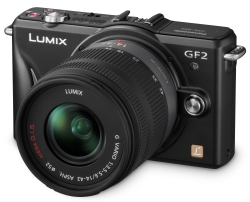 Panasonic has announced the Lumix DMC-GF2 digital camera. When it arrives here in Canada, in February, it will be the smallest and lightest interchangeable lens system camera in Panasonic’s line-up. Panasonic calls it a DSLM instead of a DSLR, because it has no mirror system, so no reflex in its name. It’s a mirrorless camera, but that’s not what the M stands for; that’s Micro. As in Micro Four Thirds, the designation of the imaging sensor size, smaller than the APS-C sensor found in many of today’s DSLRs.
Panasonic has announced the Lumix DMC-GF2 digital camera. When it arrives here in Canada, in February, it will be the smallest and lightest interchangeable lens system camera in Panasonic’s line-up. Panasonic calls it a DSLM instead of a DSLR, because it has no mirror system, so no reflex in its name. It’s a mirrorless camera, but that’s not what the M stands for; that’s Micro. As in Micro Four Thirds, the designation of the imaging sensor size, smaller than the APS-C sensor found in many of today’s DSLRs.
The GF2 is compatible with lenses from the Micro Four Thirds standard, meaning the system is compact without compromising ease of operation or image quality. The GF2 also is compatible with Panasonic’s new 3D lens, the Lumix G 12.5 mm f/12.
Thanks to a newly-designed interface, users can set the focus or release the shutter by simply touching the 3-inch touchscreen LCD. By simply locking focus on a person or object, the camera tracks the subject with the AF tracking function, even if there is movement. The contrast AF system used by the GF2 is claimed to be accurate, easy to use and very fast. Users can choose from a wide range of AF modes, including multiple-area AF with up to 23 focus areas, 1-area AF with a selectable focus area, Face Detection, and AF Tracking.
With the GF2’s newly-designed Touch Q-menu, the user can customize the camera’s shortcuts with the most commonly used settings. Simple button components include dedicated buttons for video recording and iA (Intelligent Auto) mode which lights in-use.
With the Intelligent Scene Selector in the iA mode, the camera automatically switches to the appropriate mode according to the subject touched. For example, a touch on a human face switches to the portrait mode and a touch on the background or scenery switches to the scenery mode, while a touch on the subject close to the camera switches to the close-up mode. With the MF assist mode for manual focusing, users can enlarge the subject by just a touch to select 1x, 5x or 10x and smoothly move the subject by dragging it on the screen. In iA mode and the Peripheral Defocus mode, the range of defocus can be adjusted by just moving the slider with a finger.
For the image processor, the Venus Engine FHD is incorporated, featuring exceptionally high performance signal processing capabilities in both photo and movie recording, says Panasonic. With the advanced noise reduction system employing 3D NR and CNR (Chromatic Noise Reduction), users can capture clear, naturally-balanced images even when shooting at high ISO sensitivity levels to help prevent the colour bleeding.
Panasonic’s Venus Engine FHD enables Intelligent Resolution technology, which means that three areas – outlines, detailed texture areas and soft gradation – are automatically detected. Then, the outline parts are enhanced effectively to provide clearer edges while giving a moderate accentuation to the texture areas to look more finely detailed. To the soft gradation part, the noise reduction system is applied to make it smoother. Apart from the uniform enhancement of sharpness, the innovative technology Intelligent Resolution precisely performs signal processing pixel by pixel, resulting in images that are claimed to be naturally clear and crisp in both video and photos.
The 12.1-megapixel Live MOS sensor delivers the image quality of a CCD sensor and the lower power consumption of a CMOS sensor.
Yes, there’s a dust reduction system using a supersonic wave filter in front of the Live MOS sensor.
The GF2 shoots full High Definition (HD) videos as well as photos. It can record 1920 x 1080 videos at 60i or smooth HD 1280 x 720 movies at 60p in AVCHD. The GF2 also can record HD Motion JPEG in 1280 x 720 and QVGA, VGA and WVGA. A dedicated video record button makes it easy to start shooting videos, and high quality sound is recorded with the stereo microphone for Dolby Digital Stereo Creator. Panasonic’s iA mode extends to video recording, with the following features: Optical Image Stabilizer, Face Detection, Intelligent D-range Control and Intelligent Scene Selector.
The GF2 offers My Colour mode which is integrated with the conventional Film mode. My Colour mode offers a total of eight preset effects — Expressive, Retro, Pure, Elegant, Cinema, Monochrome, Dynamic Art, Silhouette, plus Custom mode, which lets users manually set the colour, brightness, saturation, and contrast levels. Also, with the Full-time Live View function, users can see how these settings will affect the images before they shoot, which makes it easier to capture the exact effect desired. The GF2 has 17 Scene modes, most of which can be used during video shooting too. The exposure meter can be displayed in the P/A/S/M shooting modes for entry-level users to visually learn the correlation between shutter speed and aperture to enhance their photography skills.
The camera has a solid aluminum body and will be available in black or red models with the following kit options: 14-42 mm Zoom Lens Kit and 14 mm f/2.5 Lens Kit in black, white and red. There’s no pricing yet; that will come just prior to its availability.
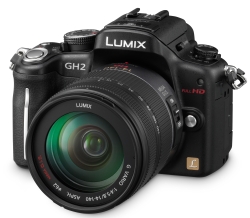
Comparisons
I’m going to include a couple more pictures here, to give some comparison. The Panasonic GH2 is closer to a DSLR in shape, and although it, too, is a mirroless design, is noticeably larger than the GF2. The new GF2 is 20 percent smaller and about seven percent lighter than its predecessor the GF1, which bears the same relative shape as the GF2.

And just for fun, here’s the Leica/Minolta CL/CLE from the mid-70s, a 35 mm film camera, rangefinder so no mirror system, without any of the fancy electronics. Just take a look at that camera back – nothing there but the viewfinder! No way of knowing if the picture was any good until your prints came back from the store or out of your home darkroom. And no video. How did we manage?
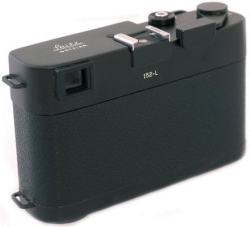
Sanyo PD2BK
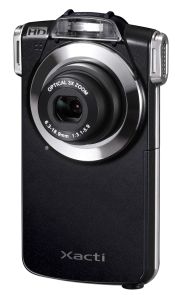 Is it a still camera or a video camera? That’s a question we can ask of many cameras now on the market. If it looks like a still camera, then we know it’s a still camera with video capability. But what if it looks like a video camera? And what if it’s another in the line of “Dual Cameras” from Sanyo? Then things get a little less straightforward.
Is it a still camera or a video camera? That’s a question we can ask of many cameras now on the market. If it looks like a still camera, then we know it’s a still camera with video capability. But what if it looks like a video camera? And what if it’s another in the line of “Dual Cameras” from Sanyo? Then things get a little less straightforward.
The new Pocket Movie Dual Camera, model VPC-PD2BK, with embedded software for easy use and sharing on social networks, shoots both stills and video: HD video (1920 x 1080 at 30p), 10-megapixel photos, built-in flash, 3x optical zoom.
The PD2BK has a High Speed Sequential Shooting Mode usually found on more expensive or larger cameras.
Files can be saved to SD, SDHC or SDXC memory cards.
The camera weighs 105 g and measures 63 x 22.1 x 110.7 mm.
Pentax 645D
 Pentax Canada says the Pentax 645D interchangeable lens medium-format DSLR will be available for sale in November, at a suggested retail price of $10,500. The smc Pentax-D FA 645 55 mm f/2.8 AL [IF] SDM AW lens will also be available at a suggested retail price of $1,250.
Pentax Canada says the Pentax 645D interchangeable lens medium-format DSLR will be available for sale in November, at a suggested retail price of $10,500. The smc Pentax-D FA 645 55 mm f/2.8 AL [IF] SDM AW lens will also be available at a suggested retail price of $1,250.
The camera was announced this past Spring.
It features a large, Kodak-made image sensor, which Pentax says is equal in performance to professional-standard digital camera backs. The sensor measures 44 x 33 mm, approximately 1.7 times larger than its 35 mm format counterparts, and offers approximately 40-megapixels.
The camera has a magnesium-steel-alloy frame, reinforced glass LCD panel protectors and a reliable dustproof, weather-resistant construction. In addition, it is designed to be compatible with the majority of the existing Pentax 645 system, including lenses.
Pentax Canada says a limited quantity of these cameras will be available.
Here are some of its features: PRIME (Pentax Real Image Engine) II, with high-speed data-processing capacity and new algorithm exclusively programmed for medium-format digital SLRs; RAW-format images as large as 50MB per file; 14-bit A/D converter; body has 70 special seals, outstanding cold-resistant performance to assure solid operation at a temperature as low as –10°C; newly designed shutter unit with a top shutter speed of 1/4000 second that can withstand as many as 50,000 shutter releases; dual SD/SDHC memory card slots; DR (Dust Removal) II mechanism; new SAFOX IX + wide-frame autofocus system with 11 sensor points (nine cross-type sensors positioned in the middle), part of an entire optical system redesign; 77-segment multi-pattern metering system; trapezoid-shaped glass prism for an approximately 98 percent field of view and Natural-Bright -Matte focusing screen.
Prototype Olympus compact
Olympus has announced it will introduce a new flagship compact camera – its first digital compact camera with a built-in Zuiko lens – in the first quarter of 2011. Like the Olympus PEN E-P2 and E-PL1 cameras, the new camera will include an accessory port so photographers will be able to expand its versatility by attaching optional accessories such as an external microphone adapter set. A prototype of the camera apparently is on display at the Photokina 2010 show in Germany this week.
Pentax Optio RS1000, RZ10
 Want to customize a camera? Then Pentax has something for you. It’s the Optio RS1000 digital compact camera, featuring a unique design which allows the user to customize the look of the camera’s exterior to reflect his or her style, or to suit a particular occasion.
Want to customize a camera? Then Pentax has something for you. It’s the Optio RS1000 digital compact camera, featuring a unique design which allows the user to customize the look of the camera’s exterior to reflect his or her style, or to suit a particular occasion.
Here’s the deal: The RS1000 has a body design which allows you to insert one of the included “skins” or a design of your choice, such as photographs, patterns or illustrations, between the body and the transparent front panel. So, yes, you can match the camera’s look to what you’re wearing or how your feeling.
There’s a removable transparent acrylic panel at the front of the main body frame. By setting a design sheet between the camera body and this panel, you can change the camera’s appearance. In addition to the alternative design sheets included in the camera box, you also can use the Tracing Stencil (included) to produce your own original designs using photos, posters, hand-drawn illustrations, etc., to create a one-of-the-kind original camera. If you choose not to personalize the look of your Optio RS1000, the camera’s front face has an attractive fine spindle finish.
The RS1000 features a 14-megapixel (effective) CCD, a 3-inch LCD monitor, a high-performance 4X optical zoom lens starting at 27.5mm (equivalent), and simple, user-friendly operation. It has a credit-card-sized body.
The Optio RS1000 will be available in Canada next month.
The camera features the new-generation Auto Picture mode, which automatically selects the most appropriate shooting mode for a given subject or scene by accurately assessing various photographic conditions. This mode instantly selects one of the 15 shooting modes (eight conventional modes, plus seven new modes including Blue Sky and Sunset) and optimizes various camera settings, including sensitivity and shutter speed, to assure the best results with minimal effort by the photographer.
The Optio RS1000 features Face Detection AF & AE, which instantly and accurately detects faces within the image field, then automatically optimizes focus and exposure settings. The camera also has Smile Capture which automatically releases the shutter the moment the camera detects the subject’s smile, and the Natural Skin mode that captures subjects with smooth, healthy skin tone.
Movies? Yup. High-definition-TV-quality movie clips (1280 x 720 pixels). It also comes equipped with the sophisticated Movie SR (Shake Reduction) mode, which automatically compensates camera shake during movie shooting with the help of exclusive software. You can also extract stills at 1280 x 720 resolution from HDTV movies in the camera.
The Optio RS1000 offers nine different digital filters, including Fish-Eye, Toy Camera, Retro and Sepia, to add various visual effects to recorded images without requiring a computer. The user can even apply multiple filters to a single image for more inventive visual effects.
Other features: Digital Blur Removal function to effectively compensate for camera shake during still-image shooting; Burst Shooting at a speed of 16 images in two seconds (fixed at 640 x 480 pixels); Auto-tracking AF mode to keep constant focus on a moving subject; Digital Panorama mode to effortlessly create a single panoramic picture from as many as three images; Green mode to automatically optimize exposure and sensitivity settings for a given subject or scene; Frame Composite function (with 20 frames stored in the camera) that lets you apply decorative photo frames when shooting the image or when playing back an image; high ISO performance up to 6400 ISO; Manual White Balance available to handle tricky mixed lighting situations.
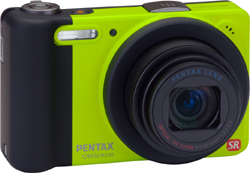 The Optio RZ10 offers a 10X optical zoom (28-280mm equivalent); 14-megapixel CCD, dual shake reduction for effective reduction of camera shake; an upgraded Auto Picture mode (selects one of 16 shooting modes – eight conventional plus eight new modes including Blue Sky, Sunset and Pet – and optimizes various camera settings, including sensitivity and shutter speed, to assure the best results); HDTV-quality movie clips (1280 x 720 pixels) and Movie SR (Shake Reduction) mode, which automatically compensates camera shake during movie shooting; Face Detection AF & AE function, detecting up to 32 faces in the image field, optimizing focus and exposure settings in a mere 0.03 seconds; Pet mode, detecting three pre-registered faces of dogs and/or cats, but also capable of automatically detecting unregistered faces of dogs and cats.
The Optio RZ10 offers a 10X optical zoom (28-280mm equivalent); 14-megapixel CCD, dual shake reduction for effective reduction of camera shake; an upgraded Auto Picture mode (selects one of 16 shooting modes – eight conventional plus eight new modes including Blue Sky, Sunset and Pet – and optimizes various camera settings, including sensitivity and shutter speed, to assure the best results); HDTV-quality movie clips (1280 x 720 pixels) and Movie SR (Shake Reduction) mode, which automatically compensates camera shake during movie shooting; Face Detection AF & AE function, detecting up to 32 faces in the image field, optimizing focus and exposure settings in a mere 0.03 seconds; Pet mode, detecting three pre-registered faces of dogs and/or cats, but also capable of automatically detecting unregistered faces of dogs and cats.
Other features: 2.7-inch colour LCD monitor; Burst Shooting of up to 40 images at a maximum speed of 9.1 images per second; digital filters, including Fish-Eye, Toy Camera and Retro; Digital Panorama mode to create a single panoramic picture from as many as three images; high ISO performance up to 6400; Manual White Balance available.
It’s available in October as well.
Three Nikon Coolpix cameras
The Coolpix P7000, S80 and S8100 join the Nikon digital camera line.
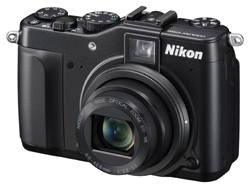
With the introduction of the 10.1-megapixel Coolpix P7000, it would appear Nikon has quashed rumours it would launch a mirrorless interchangeable lens camera – as other companies have done, to great success. The P7000 features a 1/1.7-inch CCD sensor coupled to a fixed 7.1x wide angle optical Zoom-Nikkor ED glass lens. The P7000 adopts Nikon’s new Expeed C2 high performance digital image processing engine.
ISO sensitivity ranges from ISO 100 to 6400, (expandable to ISO 12,800 in low noise Night Mode). The P7000 also offers a variety of functions that enable superior rendering when shooting at high sensitivities, says the company, including a Low Noise Night Mode and a Noise Reduction Filter. The camera also features Nikon’s 5-Way VR Image Stabilization System, which utilizes a variety of tactics including optical lens shift to minimize the effect of camera shake and help prevent blur while shooting handheld or in low-light conditions.
The Zoom Memory function allows the camera’s 28-200mm (35mm equivalent) lens to be used in a way that simulates use of a prime lens, ideal for shooting at a preferred angle of view. The P7000 also adds controls and buttons for key features such as ISO, white balance, bracketing and exposure compensation. The new independent Quick Menu dial ensures instant settings with the comfort of analog operation. Advanced users will also enjoy the benefits of shooting NRW (RAW) files (both PC- and MAC compatible).
The camera delivers macro abilities as close as 2cm.
The P7000 records HD video at 720p at 24 frames-per-second (fps) with Optical Zoom and Autofocus control. A Coolpix first, users can now record audio with an external stereo microphone (sold separately) via the microphone input. An accessory microphone or Nikon Speedlight can be mounted on the P7000’s hot shoe.
The P7000 is scheduled to hit dealers late this month, with a suggested price of $499.95.

On to camera number two, the Coolpix S80, which is equipped with a bright 3.5-inch ultra high-resolution organic LED (OLED) touch screen with enhanced interface for an easier, more enjoyable user experience. Measuring approximately 98.8 x 62.6 x 16.5mm, the super thin Coolpix S80 can easily be slipped in any pocket or bag.
With its user-friendly interface, the Coolpix S80 gives the photographer easy touch control over the camera’s key functions for smooth operation, including touch shutter shooting, zoom and playback. To help users better compose their photos, the S80 employs tab-type graphics to maximize screen space without cluttering it with icons. When the camera is rotated for vertical shooting, display tabs and controls automatically adjust to the new alignment.
The touch screen display delivers clear, rich image reproductions, bright vivid colours and excellent contrast. With a wide viewing angle (approximately 180 degrees), brightness control and an anti-reflection coating, the S80’s touch screen display makes it easy to compose, view and share photos and HD (720p) movies.
The S80 lets you add a personal touch to photos with the Paint function, giving the ability to write or draw on images during playback. The Retouch Menu lets you easily adjust images in-camera by choosing from a wide range of functions, including Colour Options, Soft Focus, Selective Colour, Cross Screen, Miniature Effect and Fish-eye Effect (which emphasizes the centre of an image as if shooting with a fish-eye lens). In playback mode, you can even add moving stamps for an animated effect. In addition, the S80 features a new rating function that allows you to rate your photos with up to five stars and sort images according to their rating.
The S80 is equipped with a built-in slide show function, allowing you to play back photos to pre-set music for an enjoyable sharing experience. The Coolpix S80 also features HD (720p) Movie with optical zoom and stereo sound available during recording. An HDMI output enables easy playback on an HDTV.
The Coolpix S80 features a 14.1-megapixel CCD sensor and 5x wide-angle optical Zoom-Nikkor ED glass lens (35-175mm equivalent).
The S80 helps reduce camera shake with a 5-Way Vibration Reduction (VR) Image Stabilization System that includes Optical and Hybrid VR, Motion Detection, ISO settings up to 6400 and Best Shot Selector, which automatically takes up to 10 shots while the shutter release button is pressed, and then selects and saves the sharpest image. The S80 employs Nikon’s Expeed C2 image processing engine.
To further help users take better photos, the Coolpix S80 includes 17 Scene Modes and the Easy Auto Mode, which automatically recognizes the shooting situation and adjusts camera settings accordingly. For outstanding portraits, the S80 features Nikon’s Smart Portrait System, which incorporates a series of automatic functions including In-Camera Red-Eye Fix, improved Face-Priority AF, Smile Timer, Blink Warning, Blink Proof and Skin Softening to flatter even the most camera-shy subject.
The S80 is scheduled to go on sale in mid-October at a suggested price of $349.95.
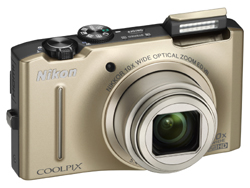
The third new Nikon camera, the Coolpix S8100, offers a 12.1-megapixel backside illumination CMOS sensor to provide you with enhanced performance for high-speed shooting and low-light conditions. The S8100 also incorporates Nikon’s Expeed C2 image processing engine, which is customized to each Coolpix model to further drive enhanced performance, image quality and HD video.
The S8100 features both high-speed shooting, and a pre-shooting cache that records up to two shots before the shutter-release is fully pressed. For extremely fast action shots, the S8100’s Sports Continuous mode records up to approximately 120 fps. With Subject Tracking, the S8100 automatically tracks a designated subject by activating autofocus (AF).
The camera is equipped with a 10x optical Zoom-Nikkor ED Glass lens (30-300mm equivalent).
The S8100 delivers Full HD (1080p), and features one-touch recording, optical zoom and stereo sound recording while filming. Additionally, there’s a new editing function and you can snap still images while recording.
The 12.1-megapixel backside illumination CMOS sensor enables exceptional image quality even when shooting in low-light settings, says Nikon. This CMOS sensor lends itself to enhanced shooting functions in dark situations, including the advanced Night Portrait mode, which reproduces night scenes and indoor portraits as users see them while reducing image blur. The Night Portrait mode combines consecutive shots of the background while the subject is taken using the flash, allowing breathtaking night scenes to be easily captured during handheld shooting and eliminating any subject movement. To further help deliver crisp, sharp photos, the S8100 features a 4-Way Vibration Reduction (VR) Image Stabilization System with ISO settings up to 3200.
Other functions aided by the new image sensor include an advanced Backlight shooting function with an in-camera high dynamic range (HDR) function, which merges images of the same scene to achieve a single image with a broad range of tonal detail.
Additionally, the S8100’s advanced Night Landscape mode combines a series of five consecutive shots taken at a fast shutter speed into a single image with reduced noise when capturing handheld shots.
The S8100 offers enhanced shooting and editing functions, including a new Mode Dial conveniently placed next to the shutter-release button for quick and easy access to shooting modes. The Coolpix S8100 also features a Creative Slider, which simplifies adjusting brightness, saturation and colour tone in-camera. Other in-camera editing functions include Quick Retouch and D-Lighting.
The camera boasts a 3-inch ultra high resolution Clear Colour Display with a wide viewing angle and anti-glare coating. Additional features include 17 Scene Modes, one being the Scene Auto Selector, which automatically recognizes the shooting situation and adjusts camera settings accordingly. The S8100 features Nikon’s Smart Portrait System, which incorporates a series of automatic functions including In-Camera Red-Eye Fix, improved Face-Priority AF, Blink Warning, Smile Timer and Skin Softening.
The S8100 is scheduled to be available early next month at a suggested price of $319.95.
Fuji W3 3D camera
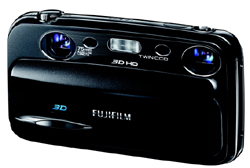 The big news in the theatres is 3D. In electronics stores it’s 3D TV. All require glasses. How about 3D without glasses?
The big news in the theatres is 3D. In electronics stores it’s 3D TV. All require glasses. How about 3D without glasses?
The Fujifilm FinePix REAL 3D W3 digital camera is that company’s next generation product to hit these shores. With it you can create your own 3D content by recording High Definition 720p 3D movies and still pictures. You can then play them back using most 3D TV systems or on the camera’s 3D LCD screen.
The new camera, says the company, is smaller, lighter, improved and now able to shoot 720p HD videos. Plus there’s stereo sound recording.
You connect the camera to your 3D TV system with an appropriate interface cable (sold separately), and watch your movies on a “big screen” in 3D. 3D glasses are required with some 3DTV systems.
With the W3 you can also view your pictures and movies directly on the camera’s 3.5-inch LCD screen without the need for special 3D glasses. That LCD delivers 1.1 million pixel resolution, compared to the more common 230,000 pixels.
The 3D processor within the camera has the ability to analyze the data from the two lenses and sensors and combines these two images into one high resolution 3D image or movie. To mimic the human eye’s ability to see perspective and depth, the W3 is equipped with two 3x optical zoom Fujinon lenses.
In fact, while human eyes are generally around 64 mm apart, the lenses in the W3 are roughly 20 percent further apart, maximizing the impression of depth, while still producing natural-looking images. Two CCD sensors each feature an effective resolution of 10-megapixels.
The FinePix W3 offers two advanced 3D shooting modes. The Individual Shutter Mode allows you to shoot one image, then move the camera and shoot a second image, after which the camera merges and saves both images as a single 3D photo. The Interval 3D Mode helps when shooting from a moving position (when you’re in a train, plane or car, for example), by capturing scenes with an extra deep-3D effect by taking two successive shots from different viewpoints.
In 3D Auto mode, the camera automatically adjusts the “parallax” (the positioning of the two pictures on top of each other) to achieve a more readily visible and natural sense of depth. You can also manually adjust the parallax using the Parallax Control lever to easily enhance the 3D effect or correct any image misalignment in the before and after shots.
The W3 is not just a 3D camera; it can be used as a normal “2D” camera as well. On the back of the camera is an easily accessible button to allow instant switching between 2D and 3D shooting and playback. The W3 comes with various advanced 2D modes. These modes use the lenses and sensors independently as if you were shooting two different photos of the same scene at the same instant. Tele/Wide Simultaneous Shooting captures a close-up and a wide angle shot at the same time; 2-colour Shooting simultaneously creates a B&W and a colour photo from one press of the shutter. You also can select Manual (M), Aperture (A) or Program Mode (P).
The 8-inch FinePix REAL 3D V1 3D photo viewer was launched in 2009 and displays 3D images and videos without 3D glasses.
In the past, to get 3D prints, you had to go online and, in effect, ship the files to Japan, where 3D prints were made, then shipped back to you. Fujifilm Canada says you will soon be able to purchase 5 x 7-inch 3D prints taken with the W3 on the www.fujifilm.ca website. Pricing details are yet to be announced.
The MyFinePix Studio Software which comes with the W3 digital camera offers simple and straightforward editing for 3D movies and photos. The software will let you convert 3D photos to JPEG format, or to re-merge JPEG images into an MPO image. And you can edit and combine your 3D movies quickly and easily. That software’s for Windows PCs only.
The FinePix Real 3D W3 will be available in September for a suggested retail price of $499.99.
Fuji F300EXR, Z800EXR-Touch
More interesting cameras from Fujifilm, the F300EXR and Z800EXR-Touch, both using the new Super CCD EXR II sensor. This new sensor now features faster autofocusing functions.
Offering a range of zoom capabilities and High Definition (HD) image and video capture, the new FinePix cameras also offer improved technologies including 360° Panoramic Shooting Mode and Web Easy Upload tool (Z800EXR-Touch) for quick and easy photo sharing on social networking sites.
 Following in the footsteps of the ‘F’ series models – the F70EXR and F80EXR – the compact F300EXR features a 15x wide-angle zoom Fujinon lens and two new focusing systems to improve autofocus time. The 15x zoom offers a versatile 24-360 mm range (equivalent) while Contrast AF and Phase Detection AF systems allow the user to achieve a faster autofocus speed. The F300EXR offers the same three EXR Priority modes (Wide Dynamic Range up to 800 percent, High Sensitivity and High Resolution) as other EXR models and EXR Auto mode takes the guesswork out of setting the camera by doing everything for you.
Following in the footsteps of the ‘F’ series models – the F70EXR and F80EXR – the compact F300EXR features a 15x wide-angle zoom Fujinon lens and two new focusing systems to improve autofocus time. The 15x zoom offers a versatile 24-360 mm range (equivalent) while Contrast AF and Phase Detection AF systems allow the user to achieve a faster autofocus speed. The F300EXR offers the same three EXR Priority modes (Wide Dynamic Range up to 800 percent, High Sensitivity and High Resolution) as other EXR models and EXR Auto mode takes the guesswork out of setting the camera by doing everything for you.
New features on this model include 360° Panoramic Shooting Function and Baby Detection (I’m sure there’s a joke here, but I’ll leave well enough alone). 360° Panoramic Shooting Function lets the user capture wide panoramic shots by simply holding the shutter once and panning around. The camera can capture vertical or horizontal panoramic shots with an extended panning range. For those tricky shots with babies or children with little patience to sit still, the F300EXR incorporates new Baby Detection mode to automatically fire the camera as soon as the subject looks into the lens.
The camera also offers Image Stabilization (CCD-Shift), Face Recognition and Pet Detection Technology that allows the user to register common photographed human or pet faces, and gives full creative control with PSAM Shooting mode.
Other benefits include: 12-megapixel EXR II sensor, a 3-inch LCD and 720p HD image and video capture.
The F300EXR will be available in black, in September, for a suggested retail price of $349.99.
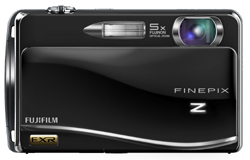 The Z800EXR-Touch is a touch screen digital camera with the EXR II sensor that automatically adjusts to all lighting and scene conditions with fast autofocusing functions. The camera features a Touch & Shoot 3.5 inch Touch Screen display panel with “HD-like” 460k pixel resolution. With this responsive screen, the user can also select the area of a shot to focus on with a simple tap of a finger and the camera will automatically focus and take the picture.
The Z800EXR-Touch is a touch screen digital camera with the EXR II sensor that automatically adjusts to all lighting and scene conditions with fast autofocusing functions. The camera features a Touch & Shoot 3.5 inch Touch Screen display panel with “HD-like” 460k pixel resolution. With this responsive screen, the user can also select the area of a shot to focus on with a simple tap of a finger and the camera will automatically focus and take the picture.
It also includes Fujifilm’s Facebook/YouTube Easy Upload tool allowing the user to mark photos for online posting right on the camera. When the camera connects to a PC with MyFinePix Studio software, all marked photos or videos upload directly at the press of a button. The camera also features 360° Panoramic Shooting Function that creates a 360° shot by holding the shutter and panning the camera.
The Z800EXR-Touch offers 1080p HD Video, a Fujinon 5x zoom lens, 12-megapixel resolution and Dual Image Stabilization – in a slim design.
Users can also rate their favourite photos with a star ranking system directly on the camera, for easy identification and sharing. Other features include Face Recognition technology with Pet Detection and Intelligent Scene Recognition.
The Z800 EXR-Touch is also coming in September, in black or red, for a suggested retail price of $229.99.
- ← Previous
- 1
- …
- 36
- 37
- 38
- Next →